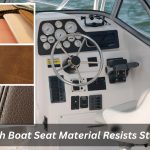How To Prevent Boat Seats From Cracking

When you own a boat, there’s nothing quite like the feeling of being out on the water, enjoying the sun and the breeze. However, to keep your boat in top condition, you need to take care of every part of it, including the often-overlooked boat seats. Boat seats can be prone to cracking, which not only affects their appearance but also their functionality. In this article, we will explore why boat seat protection is important, the causes of boat seat cracking, and most importantly, how you can prevent it.
Why is boat seat protection important?
Boat seat protection is crucial for several reasons. First and foremost, your boat seats are exposed to the elements constantly. Whether it’s the scorching sun, heavy rain, or the occasional splash from the water, boat seats take a beating. Without proper protection, these conditions can lead to unsightly cracks and damage that can be costly to repair.
Moreover, cracked boat seats are not just an aesthetic issue; they can also compromise your comfort and safety on the water. Cracks can create sharp edges that may cause injuries or snag your clothing. They can also let water seep into the seat’s foam, leading to mould and mildew growth, which can be harmful to your health.
So, to ensure your boat seats remain comfortable, safe, and visually appealing, it’s essential to invest in proper boat seat protection.
What are the causes of boat seat cracking?
Understanding the causes of boat seat cracking is the first step towards preventing it. Here are some common culprits:
- Sun exposure: Prolonged exposure to the sun’s UV rays can cause boat seats to deteriorate. The sun’s intense heat and radiation can dry out the seat’s material, making it brittle and prone to cracking.
- Water damage: Water is another major factor. Constant exposure to moisture can weaken the fabric or vinyl used in boat seats. Water can also seep into the seat’s foam, leading to rot and mildew, which can cause structural damage.
- Temperature fluctuations: Boats are often stored in environments where temperatures can vary drastically. These temperature fluctuations can cause materials to expand and contract, leading to cracks over time.
- Saltwater corrosion: If you frequently navigate in saltwater, the corrosive nature of salt can accelerate seat deterioration. Saltwater can corrode metal components and weaken the seat’s material.
- Neglect: Sometimes, the simple act of neglect can lead to cracking. Failing to clean, maintain, or cover your boat seats when not in use can leave them vulnerable to various forms of damage.
How do you stop boat seat cracking from occurring?
Now that you know what causes boat seat cracking, let’s explore how you can prevent it and keep your boat seats in top shape.
- Use a boat seat cover
One of the most effective ways to protect your boat seats from the elements is to use a boat seat cover. These covers provide a barrier against UV rays, rain, and other environmental factors. Make sure to choose a cover that fits your seats snugly to maximise protection.
- Apply a boat seat protectant
To safeguard your boat seats from water damage and UV rays, consider using a boat seat protectant. Look for a high-quality product designed specifically for marine use. Apply it as per the manufacturer’s instructions to create a protective barrier that can prolong the life of your seats.
- Clean regularly
Regular cleaning is essential to prevent the buildup of dirt, grime, and mould on your boat seats. Use a mild soap or a boat seat cleaner recommended by the manufacturer to clean the seats. Avoid using harsh chemicals or abrasive brushes that can damage the material.
- Store your boat properly
If possible, store your boat in a sheltered area or use a boat cover when it’s not in use. Keeping your boat out of direct sunlight and away from extreme temperatures can significantly extend the lifespan of your seats.
- Invest in quality seats
When purchasing or replacing boat seats, invest in high-quality, marine-grade seats. These seats are designed to withstand the rigours of boating and are less likely to crack or deteriorate quickly.
- Avoid sharp objects
Be cautious about what you bring on board. Sharp objects, like fishing hooks or tools, can easily damage your boat seats if not handled carefully. Implement proper storage and organization to minimise the risk of accidents.
What is the best boat seat protectant?
Choosing the right boat seat protectant is crucial to ensure the longevity of your seats. There are various products on the market, but the best one for you will depend on your specific needs and preferences. Look for a boat seat protectant that offers UV protection and waterproofing properties.
How do you apply a boat seat protectant?
Applying a boat seat protectant is a straightforward process. Here’s a step-by-step guide to help you get it right:
- Clean the seats: Start by thoroughly cleaning your boat seats using mild soap and water. Make sure they are dry before proceeding.
- Shake the protectant: Shake the boat seat protectant bottle well to ensure even distribution of the product.
- Apply the protectant: Spray or spread the protectant evenly over the entire surface of the boat seats. Use a soft cloth or sponge to work the product into the material, paying extra attention to seams and crevices.
- Let it dry: Allow the protectant to dry completely. This may take a few hours, depending on the product and environmental conditions.
- Repeat as needed: Follow the manufacturer’s recommendations for reapplication. In general, it’s a good practice to reapply the protectant every 4-6 weeks or as needed, especially if your boat is exposed to harsh conditions frequently.
How often should you apply a boat seat protectant?
The frequency of applying a boat seat protectant can vary depending on several factors, including the type of product you use and how frequently you use your boat. As a general guideline, reapply the protectant every 4-6 weeks or as recommended by the manufacturer. However, if your boat is exposed to particularly harsh conditions or heavy use, more frequent application may be necessary.
How to repair cracked boat seats
Despite your best efforts, boat seats may still develop cracks over time. If you notice cracks, it’s essential to address them promptly to prevent further damage. Here’s how you can repair cracked boat seats:
- Assess the damage: Examine the extent of the cracks. If they are minor, you may be able to repair them yourself. However, extensive damage may require professional help or seat replacement.
- Clean the seats: Before attempting any repairs, clean the seats to remove dirt, debris, and any loose material around the cracks.
- Fill the cracks: For small cracks, you can use a marine-grade vinyl repair kit. Follow the kit’s instructions to fill the cracks with the appropriate adhesive or filler. Make sure to match the colour as closely as possible.
- Smooth and sand: After filling the cracks, use fine-grit sandpaper to smooth the repaired area. This will help blend the repair with the rest of the seat.
- Apply vinyl patch: If the cracks are extensive or if the filler didn’t provide a satisfactory result, consider using a vinyl patch kit. This involves applying a patch of matching vinyl over the damaged area. Follow the kit’s instructions carefully.
- Protect and maintain: After finishing the repairs, make sure to apply a boat seat protectant to the entire seat, ensuring the longevity of your seats and maintaining your boat seats for maximum comfort and appearance.
In cases of severe damage or extensive cracking, it’s best to consult a professional upholstery service for repair or replacement options.
Conclusion
Protecting your boat seats from cracking is essential to ensure your comfort, safety, and the overall longevity of your boat. By understanding the causes of boat seat cracking and following preventive measures, such as using seat covers, applying a boat seat protectant, and maintaining your seats regularly, you can enjoy many seasons of worry-free boating. Remember, investing in the right protection and care for your boat seats will pay off in the long run, keeping your vessel in pristine condition for years to come.
Don’t wait until the wear and tear on your boat seats become noticeable! Take proactive measures now to safeguard your valuable investment and ensure countless enjoyable outings on the water. Sege Seats proudly offers premium boat seats designed specifically for marine enthusiasts like you. Our products are meticulously crafted to withstand the very elements that lead to the cracking and deterioration of boat seats. When you choose Sege Seats, you’re making an investment in your comfort and safety during your aquatic adventures. Why take the risk of dealing with the inconvenience and expense of seat repairs when you can protect your seats with Sege Seats? Get in touch with us today and take the first step toward ensuring that your boat seats remain in pristine condition for years to come!





